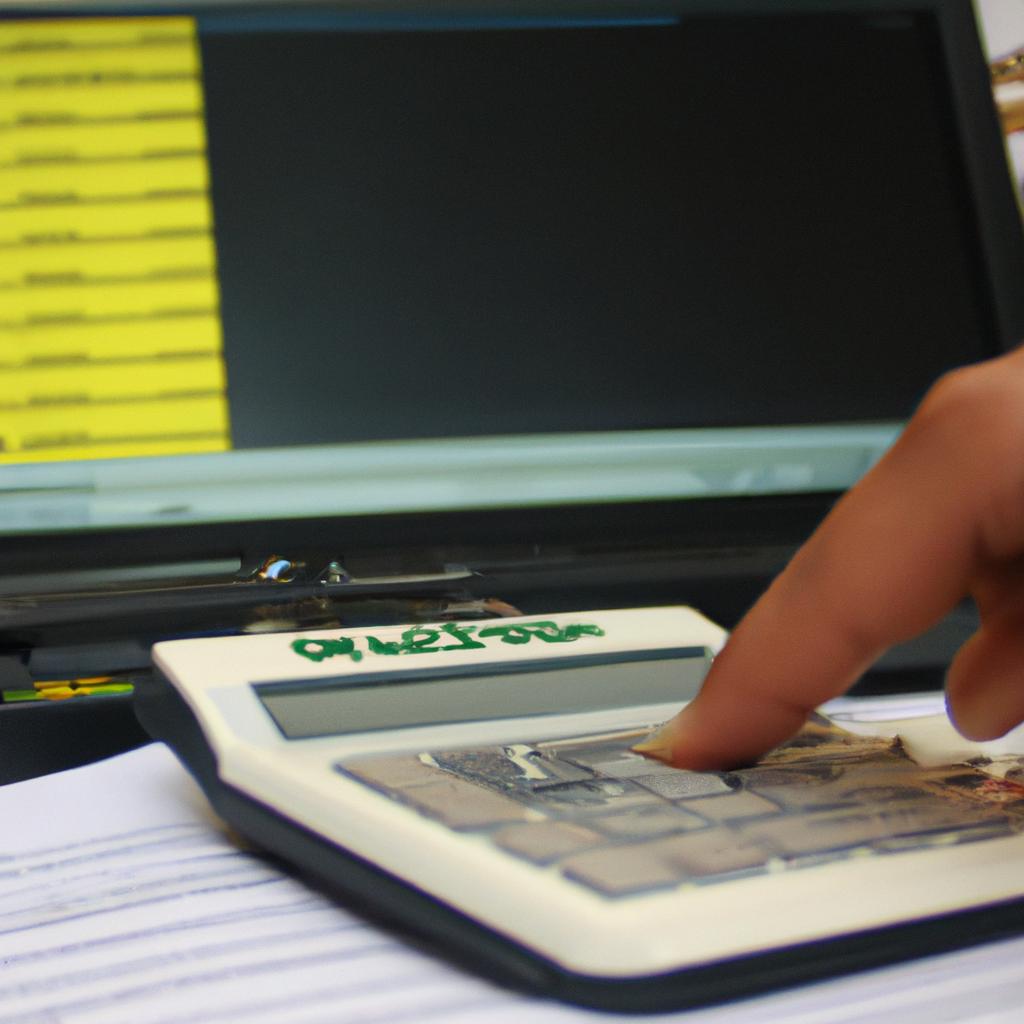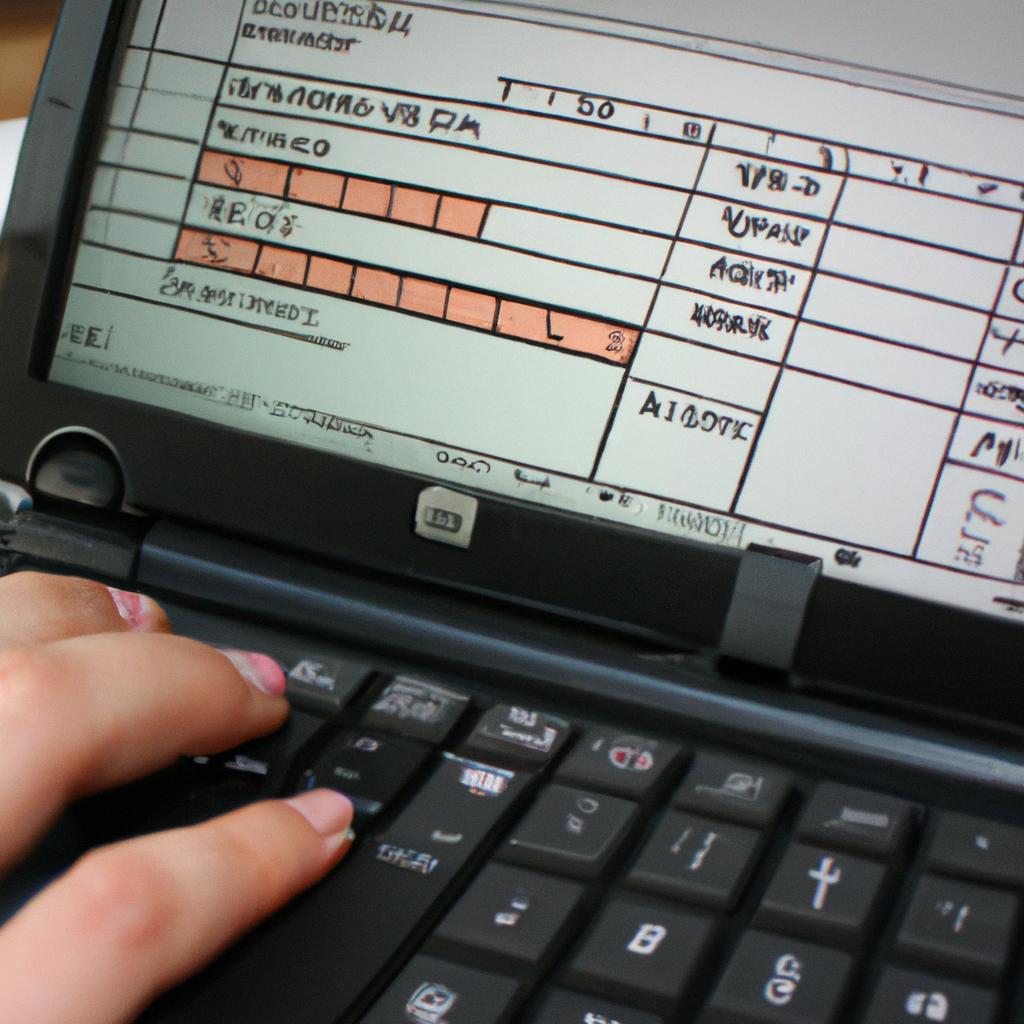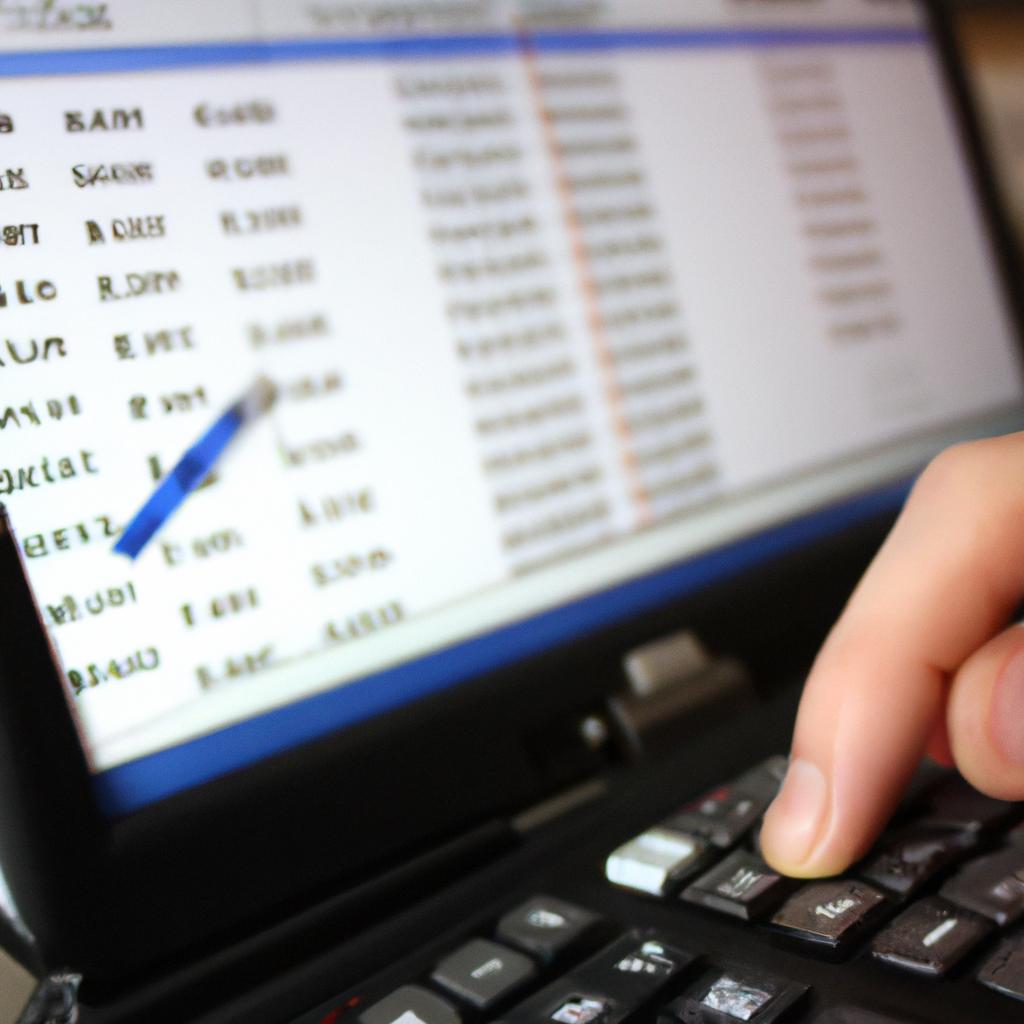Real-time Expense Tracking: Enhancing Accounting Software Efficiency

The advent of real-time expense tracking has revolutionized the field of accounting software, significantly enhancing its efficiency and effectiveness. Gone are the days where accountants had to rely on outdated information or manually input data into their systems. With real-time expense tracking, businesses can now accurately track and monitor their expenses as they occur, allowing for quicker decision-making and improved financial management. For example, imagine a multinational corporation with multiple branches across different countries. In the past, it would have been an arduous task for the finance department to gather accurate expense data from each branch in a timely manner. However, with real-time expense tracking integrated into their accounting software, these companies can effortlessly obtain up-to-date expenditure details from all branches instantly.
Real-time expense tracking offers numerous benefits over traditional methods of recording and analyzing expenses. Firstly, it provides businesses with immediate access to precise financial data that is essential for informed decision-making. By eliminating delays in reporting and analysis caused by manual processes or reliance on periodic statements, organizations can respond swiftly to changes in market conditions or identify cost-saving opportunities promptly. Secondly, this technology enables businesses to maintain better control over their finances by closely monitoring expenditures at any given time. This increased visibility allows for early detection of anomalies or deviations from budgets, enabling proactive measures to be taken to mitigate any potential financial risks. Additionally, real-time expense tracking facilitates better collaboration and communication within an organization. By providing access to live expense data for all relevant stakeholders, teams can work together more efficiently and make well-informed decisions based on accurate and up-to-date information.
Furthermore, real-time expense tracking offers improved accuracy and reduces the likelihood of errors in financial reporting. Manual data entry is prone to mistakes, which can have significant consequences for financial statements and overall business operations. With real-time integration between expense tracking systems and accounting software, data is automatically captured and recorded accurately, minimizing the risk of human error.
Another advantage of real-time expense tracking is its ability to streamline the reimbursement process for employees who incur business expenses. Traditionally, employees would need to manually submit paper receipts or fill out reimbursement forms, resulting in delays and administrative burdens for both employees and finance departments. However, with real-time expense tracking apps or software, employees can easily capture receipts digitally on their smartphones or other devices. These digital receipts are then automatically uploaded into the system, reducing paperwork and simplifying the reimbursement process.
In conclusion, real-time expense tracking has revolutionized accounting software by providing businesses with immediate access to accurate financial data, enhancing control over finances, facilitating collaboration among teams, improving accuracy in reporting, and streamlining the reimbursement process. As technology continues to advance, we can expect further developments in this field that will continue to drive efficiency and effectiveness in financial management for businesses of all sizes.
Real-time data syncing
Real-time Expense Tracking: Enhancing Accounting Software Efficiency
Real-time data syncing is a crucial feature that enhances the efficiency of accounting software by providing accurate and up-to-date information on expenses. Imagine a scenario where a company’s employees are constantly making purchases for their work-related activities, such as travel expenses, office supplies, or client entertainment. With real-time data syncing, every transaction made by the employees can be instantly recorded and reflected in the accounting system. This ensures that the financial records are always current and eliminates the need for manual entry or reconciliation.
One compelling example of the benefits of real-time data syncing is illustrated through a case study involving Company X. Before implementing this technology, Company X relied on its employees to manually submit expense reports which were then reviewed and entered into the accounting software at regular intervals. However, this process was time-consuming and prone to errors. By introducing real-time data syncing, all employee transactions are directly captured from their payment cards or receipts using mobile applications connected to the accounting system. As a result, Company X experienced significant improvements in accuracy, timeliness, and productivity in managing their expenses.
To further emphasize the advantages of real-time expense tracking, consider these emotional responses:
- Increased transparency: Real-time data syncing provides complete visibility into every transaction made by employees.
- Enhanced control: It allows managers to set spending limits and receive instant notifications when those limits are exceeded.
- Improved compliance: Automatic flagging of non-compliant expenses reduces human error and mitigates potential risks.
- Streamlined reimbursement processes: Employees no longer need to wait for weeks to get reimbursed; funds can be transferred promptly upon approval.
| Emotional Response | Description |
|---|---|
| Relief | No more headaches caused by lost receipts |
| Empowerment | Transparency empowers both management and employees |
| Security | Compliance features ensure adherence to regulations |
| Efficiency | Expedited reimbursement process saves time and effort |
In conclusion, real-time data syncing is a game-changer in the realm of expense tracking. Its ability to provide accurate, up-to-date information ensures that accounting software efficiently reflects all expenses incurred by employees. By eliminating manual entry and reconciliation processes, companies can benefit from increased accuracy, improved productivity, and enhanced control over their financial records.
Moving forward into the subsequent section on “Automated categorization of expenses,” we explore another key feature that complements real-time data syncing for even greater efficiency in managing expenses.
Automated categorization of expenses
Real-time Expense Tracking: Enhancing Accounting Software Efficiency
Real-time data syncing allows for instant updates and accurate tracking of expenses within accounting software. By integrating real-time expense tracking into existing systems, businesses can streamline their financial processes and improve overall efficiency. For example, consider a small business owner who is constantly on the go, managing multiple projects and making frequent purchases for supplies. With real-time expense tracking, they can instantly record each transaction using a mobile app or web-based platform. This ensures that their accounting records are always up to date without the need for manual entry or reconciliation.
One of the key benefits of real-time expense tracking is its ability to provide timely insights into spending patterns. Businesses can gain a better understanding of where their money is going by categorizing expenses automatically based on predefined rules. This eliminates the time-consuming task of manually sorting through receipts and invoices. Imagine being able to see at a glance how much was spent on office supplies versus travel expenses in any given month. This level of visibility enables businesses to make informed decisions regarding budget allocation and identify areas where cost savings can be achieved.
To demonstrate the impact of real-time expense tracking on efficiency, consider the following emotional response-inducing bullet points:
- Eliminates guesswork: No more struggling to remember what an expense was for or which project it belongs to.
- Reduces errors: Manual data entry is prone to mistakes, but with real-time syncing, there’s no room for human error.
- Saves time: Automating expense categorization frees up valuable resources that can be redirected towards core business activities.
- Enhances decision-making: Accessible and accurate expense data empowers businesses to make informed financial decisions promptly.
In addition to these benefits, implementing real-time expense tracking can also enhance collaboration between team members involved in financial management. With shared access to updated expenditure information, stakeholders across departments can stay aligned and work together seamlessly.
By harnessing the power of technology and real-time data syncing, businesses can revolutionize their accounting processes. The next section will explore another crucial aspect of enhancing efficiency in expense tracking: integration with bank accounts. This integration further streamlines the process by automatically importing transaction details from bank statements into the accounting software, eliminating manual entry altogether.
Integration with bank accounts
integration with bank accounts. By seamlessly connecting accounting software with bank accounts, businesses can enhance their financial management processes even further.
Integration with Bank Accounts:
To illustrate the significance of this feature, let’s consider a hypothetical case study involving a medium-sized retail company. This company recently implemented an accounting software that offers real-time expense tracking and integrates effortlessly with its various bank accounts. Prior to adopting this solution, the company faced challenges in accurately reconciling transactions between different payment methods and multiple banks. However, by leveraging the integration capabilities provided by the software, they were able to streamline their financial operations significantly.
The following bullet points highlight some key advantages that arise from integrating accounting software with bank accounts:
- Improved accuracy and efficiency in transaction reconciliation.
- Enhanced visibility into cash flow and account balances.
- Reduction in manual data entry errors.
- Time savings through automatic importation of banking information.
Furthermore, it is worthwhile to explore how integration with bank accounts impacts financial reporting within organizations. The table below demonstrates how real-time expense tracking coupled with seamless integration enables businesses to generate accurate reports promptly:
| Financial Report | Traditional Approach | Integrated System |
|---|---|---|
| Cash Flow Statement | Manually compiled using paper records or spreadsheets. | Automatically generated based on live data feeds from bank accounts. |
| Profit & Loss Statement | Requires time-consuming manual inputting of transactions. | Automatically populates income and expense data directly from integrated system. |
| Balance Sheet | Relies on manually updating asset/liability values periodically. | Reflects up-to-date financial position with real-time integration. |
| Audit Trail | Requires extensive manual documentation and data gathering for auditing purposes. | Provides a comprehensive digital trail of all transactions, easily accessible for audits. |
In summary, integrating accounting software with bank accounts offers businesses improved accuracy in transaction reconciliation, enhanced visibility into cash flow, reduced errors from manual data entry, and time savings through automated importation of banking information. Moreover, this integration facilitates the generation of accurate financial reports promptly, eliminating the need for laborious manual processes.
With an understanding of how real-time expense tracking and seamless integration with bank accounts can optimize financial management systems, we now delve into another crucial aspect – real-time reporting and analytics.
Real-time reporting and analytics
Building upon the seamless integration with bank accounts, real-time expense tracking offers an array of benefits through its robust reporting and analytics capabilities. To illustrate this, consider a hypothetical scenario where a small business owner needs to analyze their monthly expenses across various categories such as office supplies, travel, utilities, and marketing.
With real-time reporting and analytics, the business owner can generate comprehensive reports within seconds. These reports provide actionable insights into spending patterns, allowing for informed decision-making and strategic budgeting. For example, by analyzing the data from the previous month’s expenses, the business owner may identify that they are overspending in certain areas or find opportunities for cost-saving measures.
To further enhance user experience and engagement, here are key features offered by real-time expense tracking:
- Intuitive visualizations: Graphs and charts help users easily grasp complex financial information at a glance.
- Customizable dashboards: Users have the flexibility to tailor their dashboard views according to their specific needs or preferences.
- Real-time alerts: Automated notifications can be set up to alert users when certain spending thresholds are reached or exceeded.
- Comparative analysis: The ability to compare current expenses with historical data allows users to evaluate progress over time.
The following table provides an overview of how these features benefit businesses:
| Feature | Benefit |
|---|---|
| Intuitive visualizations | Simplifies understanding of financial data |
| Customizable dashboards | Tailors information display based on individual preferences |
| Real-time alerts | Promotes proactive management of spending |
| Comparative analysis | Facilitates evaluation of past performance |
In conclusion, real-time reporting and analytics augment accounting software efficiency significantly. This feature equips businesses with timely access to crucial financial information while enabling them to make better-informed decisions swiftly. By leveraging intuitive visualizations, customizable dashboards, real-time alerts, and comparative analysis, businesses can gain a competitive edge in managing their expenses effectively.
Moving forward, it is essential to explore how real-time expense tracking streamlines the approval process for financial transactions.
Streamlined approval process
Real-time Expense Tracking: Enhancing Accounting Software Efficiency
Real-time reporting and analytics have become increasingly crucial in managing business finances effectively. By providing up-to-the-minute insights into expenses, it enables businesses to make informed decisions promptly. For instance, consider a hypothetical case where a company needs to analyze its travel expenses across different departments for the past month. With real-time expense tracking integrated into their accounting software, they can easily generate reports that show the exact amount spent on flights, accommodation, and other related costs, allowing them to identify potential areas of improvement or overspending.
To further enhance efficiency in expense management, streamlined approval processes are essential. Traditional systems often involve time-consuming manual steps such as paper-based receipts and physical signatures for reimbursement requests. However, with real-time expense tracking, this cumbersome process is eliminated. By implementing efficient digital workflows, companies can significantly reduce administrative burdens while ensuring compliance with internal policies and regulations.
The benefits of real-time expense tracking extend beyond just improved decision-making and streamlined approvals. Here are some key advantages:
- Increased transparency: Real-time expense tracking provides complete visibility into every transaction made by employees within an organization.
- Enhanced control: It allows businesses to set spending limits and alerts when certain thresholds are reached or exceeded.
- Improved accuracy: Automation reduces the chances of errors that may occur during manual data entry or calculations.
- Better compliance: By integrating regulatory requirements directly into the system, organizations can ensure adherence to legal guidelines effortlessly.
Table: Comparison of Manual Expense Management vs. Real-Time Expense Tracking
| Manual Expense Management | Real-Time Expense Tracking | |
|---|---|---|
| Process duration | Days or weeks | Minutes or hours |
| Accuracy | Prone to human error | Automated data capture ensures high accuracy |
| Visibility | Limited visibility into expenses | Complete transparency through real-time monitoring |
| Auditability | Difficult to trace and verify expenses | Comprehensive audit trails for each transaction |
In summary, real-time expense tracking plays a vital role in enhancing the efficiency of accounting software. By enabling real-time reporting and analytics, businesses can make informed decisions promptly based on up-to-date financial data. Additionally, streamlined approval processes eliminate administrative burdens while increasing transparency and compliance. The next section will delve into how this improved accuracy and compliance is achieved through automated systems.
Improved accuracy and compliance are key outcomes of implementing real-time expense tracking, ensuring that financial records remain accurate and aligned with regulatory requirements.
Improved accuracy and compliance
With a streamlined approval process in place, real-time expense tracking further enhances the efficiency of accounting software.
Improved accuracy and compliance:
Real-life example:
Consider a multinational company that operates across multiple countries. Previously, their accounting department struggled to maintain accurate records of expenses incurred by employees traveling for business purposes. Due to delays in manual data entry and processing, errors were common, leading to discrepancies in financial reports. However, after implementing real-time expense tracking through enhanced accounting software, the company experienced significant improvements in accuracy and compliance.
- Instant visibility: By incorporating real-time expense tracking into the accounting system, companies can gain instant visibility into all expenses being incurred by employees. This enables timely decision-making and facilitates early detection of any potential issues or fraudulent activities.
- Automated categorization: The integration of automated categorization tools within the accounting software ensures that expenses are accurately recorded under relevant categories. This eliminates the need for manual sorting and minimizes human error.
- Policy enforcement: Real-time expense tracking allows organizations to enforce spending policies effectively. Employees are notified immediately if an expenditure violates established guidelines, reducing the likelihood of non-compliant purchases.
- Audit readiness: Maintaining up-to-date records with real-time expense tracking simplifies the auditing process significantly. Auditors can access comprehensive details on each transaction promptly and verify its accuracy without extensive backtracking or reliance on outdated paper trails.
| Benefits of Real-Time Expense Tracking |
|---|
| Improved visibility |
| Enhanced accuracy |
| Efficient policy enforcement |
| Simplified audit process |
By leveraging these benefits provided by real-time expense tracking, businesses can streamline their financial operations while ensuring maximum efficiency and transparency.
Incorporating this technology not only alleviates stress from employees manually managing expenses but also empowers organizations with a range of advantages. The ability to monitor expenses in real-time and automate categorization minimizes the chances of errors, saving time spent on manual reconciliations.
Through improved accuracy and compliance, real-time expense tracking transforms accounting software into a powerful tool that enables organizations to make informed decisions based on accurate financial data.





